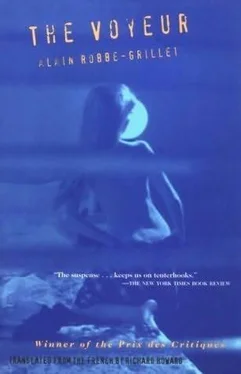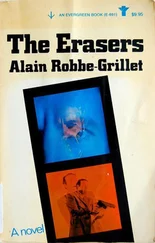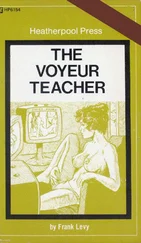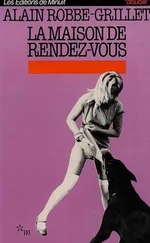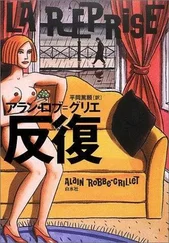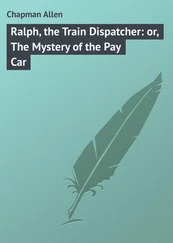He glanced around for the suitcase, but immediately remembered he had left it in his room that morning. He thanked the man again and picked up the chair to return it to the café, but the man took it out of his hands, and the only thing left for the salesman to do was to leave—by the road to the solitary cottage in its reed-filled valley at the back of the narrow cove.
In spite of the half-darkness, he walked on unhesitatingly. When the path followed the edge of the cliff, above the sea, he felt no fear whatsoever, although scarcely making out where he was putting his feet. With sure steps he climbed down toward the house, where a single, curtainless window showed a reddish gleam in the blue twilight.
He bent his head toward the panes. Despite the accumulated dust clinging to the surface, what was happening inside could be seen quite clearly. It was rather dark, especially in the corners. Only the objects near the source of light were really clear to Mathias—who was standing sufficiently far back to remain invisible to anyone inside.
The scene is lit by an oil lamp in the middle of the long, blackish-brown table. Also on the table, between the lamp and the window, are two white plates next to each other—touching each other—and an uncorked liter bottle of which the dark glass prevents any certainty as to the color of the liquid filling it. The rest of the table is clear, marked only with a few shadows: the huge, distorted one cast by the bottle, a crescent underlining the plate nearest the window, a large spot surrounding the lamp base.
Behind the table, in the room’s right corner (the one farthest away), the big kitchen stove against the rear wall can be discerned by an orange glow from the open ash-drawer.
Two people are standing face to face: Jean Robin—called Pierre—and, much shorter than he, the young woman of unknown identity. Both are on the other side of the table (in relation to the window), he to the left—that is, in front of the window—she at the opposite end of the table, near the stove.
Between them and the table—running its whole length but concealed from view by it—is the bench. The entire room is thus cut up into a network of parallel lines: first the back wall, against which, at the right, are the stove and several boxes, and at the left, in shadow, some more important piece of furniture; next, at an unspecifiable distance from this wall, the line determined by the man and the woman; then, still advancing toward the front of the room, the invisible bench, the central axis of the rectangular table—including the oil lamp and the opaque bottle—and the window itself.
Cutting across this system by perpendiculars, from front to back, the following elements can be discerned: the central upright of the window, the shadow crossing the second plate, the bottle, the man (Jean Robin, or Pierre), a crate set upright on the floor; then, a yard to the right, the lighted oil lamp; and about a yard farther, the end of the table, the young woman of unspecified identity, and the left side of the stove.
Two yards—or a little more—separate the man from the woman. She lifts her timorous face toward him.
At this moment the man opens his mouth, moving his lips as if talking, but nothing can be heard by the observer behind the square panes. The window is too tightly closed; or the noise of the sea behind him, breaking against the reef at the mouth of the cove, is too loud. The man does not articulate his words clearly enough for the syllables to be counted. He has been speaking slowly for some ten seconds—which must be about thirty syllables, perhaps less.
In reply the young woman screams something—four or five syllables—at the top of her lungs, it appears. Yet this time too, nothing can be heard through the glass. Then she steps forward toward the man and rests one hand (the left) on the edge of the table.
Now she is looking at the lamp and says a few words more—less intensely—as her features become progressively more distorted and a grimace narrows her eyes, widens the corners of her mouth, and raises the wings of her nostrils.
She is crying. A tear can be seen falling slowly down her cheek. The girl sits down on the bench; without putting her legs between it and the table, she turns the upper part of her body toward the latter and rests her forearms on it, hands clasped. Finally she lets her head droop forward, her face hidden in her hands. Her golden hair gleams in the lamplight.
Then the man slowly approaches, stands behind her, stares at her for a moment, stretches out his hand, and slowly caresses the nape of her neck with his fingertips. The huge hand, the blond head, the oil lamp, the edge of the first plate (on the right), and the left upright of the window are all aligned in the same oblique plane.
The lamp is made of brass and clear glass. From its square base rises a cylindrical, fluted stem supporting the oil reservoir—a half-globe with its convexity underneath. This reservoir is half-full of a brownish liquid which does not resemble commercial oil. On its upper part is a flange of stamped metal an inch and a half high, into which is screwed the glass—a perpendicular tube widening slightly at the base. It is this perforated flange, brightly lighted from within, which can be seen most clearly of all the articles in the room. It consists of two superimposed series of equal tangent circles—rings, more exactly, since their centers are holloweach ring of the upper series being exactly above a ring of the lower row to which it is joined for a fraction of an inch.
The flame itself, produced from a circular wick, appears in profile in the form of a triangle deeply scalloped at the apex, therefore exhibiting two points rather than just one. One of these is much higher than the other, and sharper as well; the two joints are united by a concave curve—two asymmetrical, ascending branches on each side of a rounded depression.
Blinded from staring at the lamp too long, Mathias finally turned away his eyes. To rest them, he examined the window itself—four identical panes with neither curtain nor shade, looking out into the darkness of the night. He blinked violently several times, pressing his eyeballs in order to get rid of the circles of fire still printed on his retinas.
He brought his head close to the glass and tried to look through, but could see nothing: neither sea nor moon nor even the “garden. There was no sign of the moon or the stars—the darkness was complete. Mathias returned to his memorandum book, open at the day’s date—Wednesday—on the massive little table wedged into the window recess.
He re-read the schedule he had just brought up to date, accounting for his recent movements. For the day that had just passed, on the whole, there was little to suppress, or to add. And besides, he had met too many witnessess.
He turned back a leaf, found himself at Tuesday, and once again went over the imaginary succession of minutes between eleven in the morning and one in the afternoon. He confined himself to closing the ill-formed loop of an eight with the point of his pencil. Everything else was in order.
But he smiled, thinking of the futility of his task. Such a concern for exactitude—unaccustomed, excessive, suspect—far from clearing him, rather tended to accuse.… In any case, it was too late. Young Julian Marek had probably turned him in late that afternoon. Certainly after their encounter at the edge of the cliff the boy’s doubts had vanished completely; the salesman’s words and ridiculous behavior gave him away indisputably, without even taking into account what Julian knew already, perhaps from having seen it with his own eyes. Tomorrow, early in the morning, the old Civil Guard would come to arrest “the unspeakable individual who… ,” etc. There was no hope of escaping in a fishing boat: the police in all the little mainland harbors would be waiting for him as he arrived.
Читать дальше
